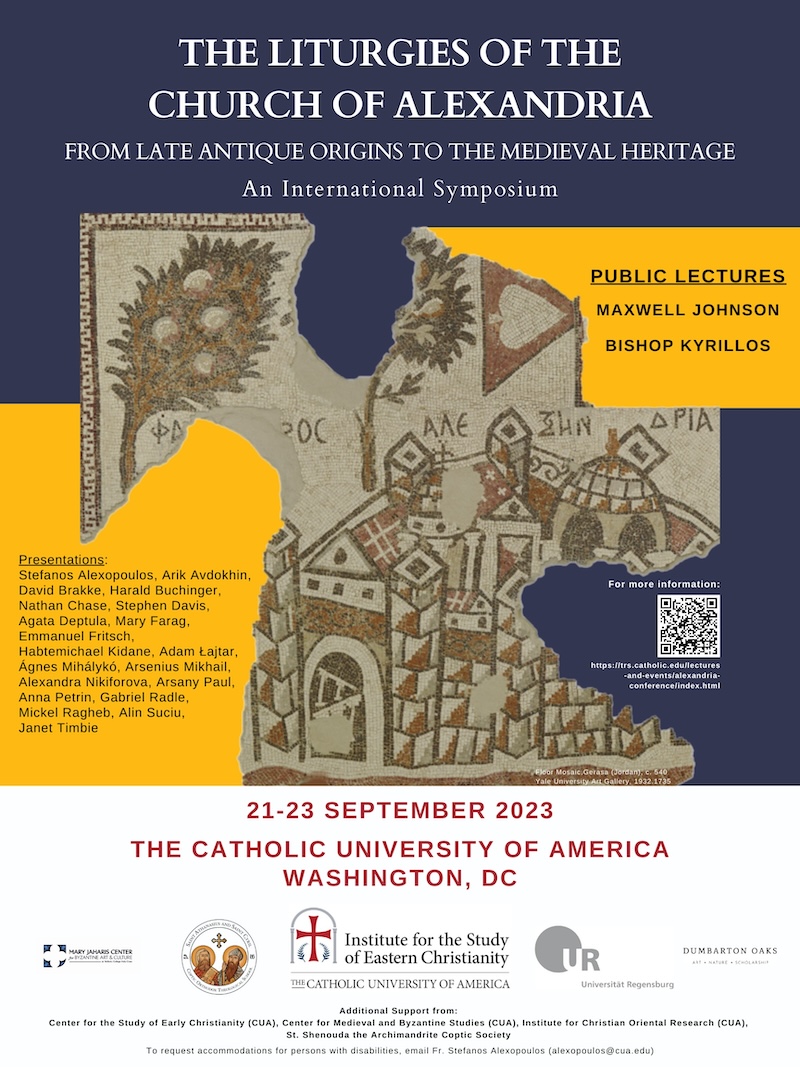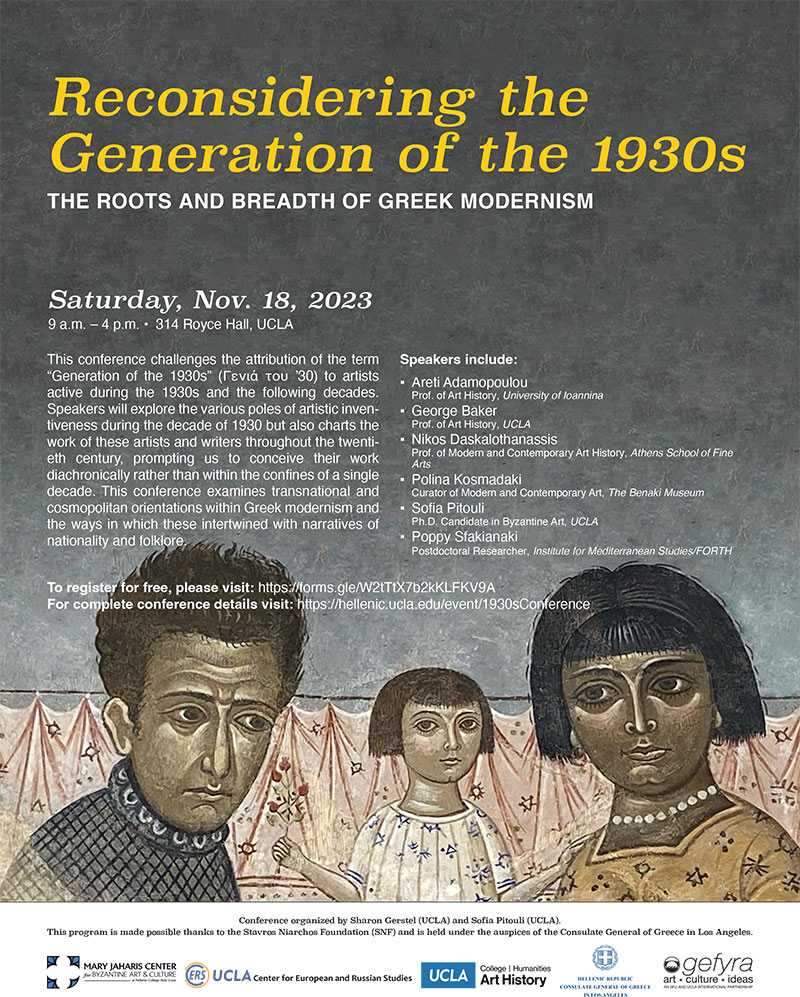Past Recipients
2023–2024
Rev. Fr. Stefanos Alexopoulos, Catholic University of America
Event: The Liturgies of the Church of Alexandria: From Late-Antique Origins to the Medieval Heritage. Award amount: $5000

The Institute for the Study of Eastern Christianity at The Catholic University of America, with the cooperation of the Liturgy Chair at the University of Regensburg (Germany) and the St. Athanasius and Saint Cyril Coptic Orthodox Theological School, on September 21-23, 2023 organized and hosted the International Symposium “The Liturgies of the Church of Alexandria: From Late-Antique Origins to the Medieval Heritage”.
This international symposium gathered 20 outstanding scholars from all over the world, each the top specialist in their respective fields, and was, globally, the first ever such conference dedicated in such breadth to the investigation of the Liturgy of Alexandria, its origins, its impact and its legacy. It covered the early Alexandrian tradition, the Greek speaking Chalcedonian tradition, the Coptic tradition, the Ethiopian tradition, and the now extinct Nubian tradition, through biblical, liturgical, patristic, and ascetical texts, through papyrus, parchment and paper manuscripts and fragments, through wall inscriptions, and architectural studies. The conference was well received and well attended. Thanks to the excellence of the presentations, the liveliness of the discussions and exchanges, and the originality of the research, the papers of the conference will be published in a volume by the Catholic University of America Press. In this way, this conference will have a lasting impact in the scholarly world and interested scholars may enjoy the wisdom, knowledge, and research shared during the conference.
The two public lectures, one by Maxwell Johnson and one by Bishop Kyrillos, were also live-streamed and are available for viewing on the Institute for the Study of Eastern Christianity's YouTube page.
This conference would not have been possible without the generous support of the Mary Jaharis Center for Byzantine Art and Culture.
Additional support was received from the Center for the Study of Early Christianity, the Institute of Christian Oriental Research and the Center for Medieval and Byzantine Studies, all at The Catholic University of America, Dumbarton Oaks, the St. Shenouda the Archimandrite Coptic Society, St Mark Coptic Orthodox Church, St. Philopater Coptic Orthodox Church, and Meda Coffee and Kitchen Ethiopian Restaurant.
2022–2023
Sharon E. J. Gerstel, UCLA
Event: Reconsidering the Generation of the 1930s: The Roots and Breadth of Greek Modernism. Award amount: $2500

A one-day conference, “Reconsidering the Generation of the 1930s: The Roots and Breadth of Greek Modernism,” was held at UCLA on November 18, 2023. Organized by Sharon Gerstel, Professor of Byzantine Art and Archaeology, and Sofia Pitouli, Ph.D. candidate in Byzantine Art and Archaeology, the conference challenged the attribution of the term “Generation of the 1930s” (Γενιά του ’30) to poets and writers of the era. The artists of the so-called “Generation of the 1930s” were credited with the creation of modernism in Greece, which was inspired by Western European movements but was also deeply rooted in history, particularly in Orthodox Byzantium and the Greek folk tradition. The conference explored the various poles of artistic inventiveness during the 1930s. It examined artists’ work throughout the twentieth century, prompting us to conceive their work diachronically rather than within the confines of a single decade. Given the socio-political circumstances of the nineteenth century in Greece—the traumatic changes resulting from the Greco-Turkish war, the ensuing population exchange, the collapse of the Megali Idea, the dramatic upheavals of interwar Greece, the Metaxas dictatorship, and the Junta regime—the conference also examined transnational and cosmopolitan orientations within Greek modernism and how these intertwined with narratives of nationality and folklore.
Seven speakers from Los Angeles and Greece addressed the conference topic from various perspectives. In her paper “Approaching Byzantine and Modern Geraki through the Eyes of Kontoglou and Tsarouchis,” Sharon Gerstel (Professor of Byzantine Art and Archaeology, UCLA) examined how, between 1931 and 1934, the painters Fotis Kontoglou and Yannis Tsarouchis were deeply engaged in the study of Byzantine churches and folk art. She focused on the village of Geraki, known for its Byzantine churches and rich folk tradition of weaving. In her talk, she also examined the critical role of the Greek Byzantinist Andreas Xyngopoulos in the work of the artists in the early 1930s. Areti Adamopoulou (Professor of Art History, University of Ioannina), in her talk “The ‘Generation of the 1930s’ in Art: Cold War Cultural Politics and Modern Painting in Greece,” examined how from initial references to the country’s landscape and the Athenian light to formal elements and subjects taken from Byzantine and Greek cultural history and traditions, the quest for “Greekness” played a decisive role in the formation of a local version of European modern art. Nikos Daskalothanasis (Professor of Modern and Contemporary Art History, Athens School of Fine Arts) focused on the painter Theophilos (Hatzimihail), problematizing his placement under the umbrella term “Generation of the 1930s” since he died in 1934. The artist’s “primitive” visual idiom and his idiomatic modernist language, according to Daskalothanasis, influenced later painters who saw these contradictions in their own goals as bearers of European modernity. Drawing on the testimony of writers and intellectuals of the period, Poppy Sfakianaki (Postdoctoral Researcher, Institute for Mediterranean Studies/FORTH) asserted that the artists who lived and worked in Paris during the interwar years did not belong to only one group nor did they identify as members of a generation. Examining the impact of Paris on the artists of the “Generation” and the effects of Paris after their return to Greece, she suggested that what bound the artists together were shared aesthetic ideas and a system of networks (relational, professional, economic) rather than the vague concept of “generation.” George Baker (Professor of Art History, UCLA), in his paper “Yannis Tsarouchis and Anachronic Modernism: Lateness, Counter-Memory, and the Redefinition of the Human,” looked closely at Tsarouchis’ origins as a painter and addressed the contexts—from abstraction to Surrealism—within and against which the artist defined his work. Polina Kosmadaki (Curator
of Modern and Contemporary Art, The Benaki Museum) examined in her paper “Concepts of Artistic “Greekness” in the Post-Junta Period: The Case of the Exhibition of Tsarouchis, Ghika, Kontoglou, Theofilos in the Greek Month in London, 1975,” a major artistic event which animated the art world right after the fall of the Dictatorship in Greece and provoked heated debates around national identity and the international re-framing of Greek art. A vital exhibition included in the Greek Month focused on the work of four critical painters associated with the “Generation of the 1930s”: Theofilos, a naive painter who was heralded at the time as representing the most authentic expression of Greek art; Fotis Kontoglou, who revisited Byzantine tradition and whose work was framed as a version of local expressionism; Yannis Tsarouchis, who had developed a personal manner of depicting everyday Greek reality; and Nikos Hadjikyriakos-Ghikas, a Greek post-cubist painter who frequented the circles of Picasso. Sofia Pitouli (Ph.D. Candidate in Art History, UCLA), in her paper “Toward Greekness: Dimitris Pikionis’ Architectural Fantasies of Japan,” explored how the architect Dimitris Pikionis employed a version of Japan in his tectonic works in the decade of 1930s, which in 1956 shaped the paved storylines leading to the Acropolis and around the Philopappos Hill. By intertwining the Classical (Acropolis) and Byzantine (the 9th-century church of Hagios Dimitrios Loumbardiaris) layers of art, architecture, and history of the 80,000-meter complex with Japanese references, Pikionis synthesized a modern Greek identity.
In addition to generous support from the Mary Jaharis Center for Byzantine Art and Culture, the conference received funding from the UCLA Department of Art History, the UCLA Center for European and Russian Studies and the UCLA SNF Hellenic Center for the Study of Hellenic Culture. The UCLA SNF Hellenic Center and the SNF Centre for Hellenic Studies at Simon Fraser University, Vancouver, hosted the conference through Gefyra, a collaborative program underwritten by the Stavros Niarchos Foundation (SNF).